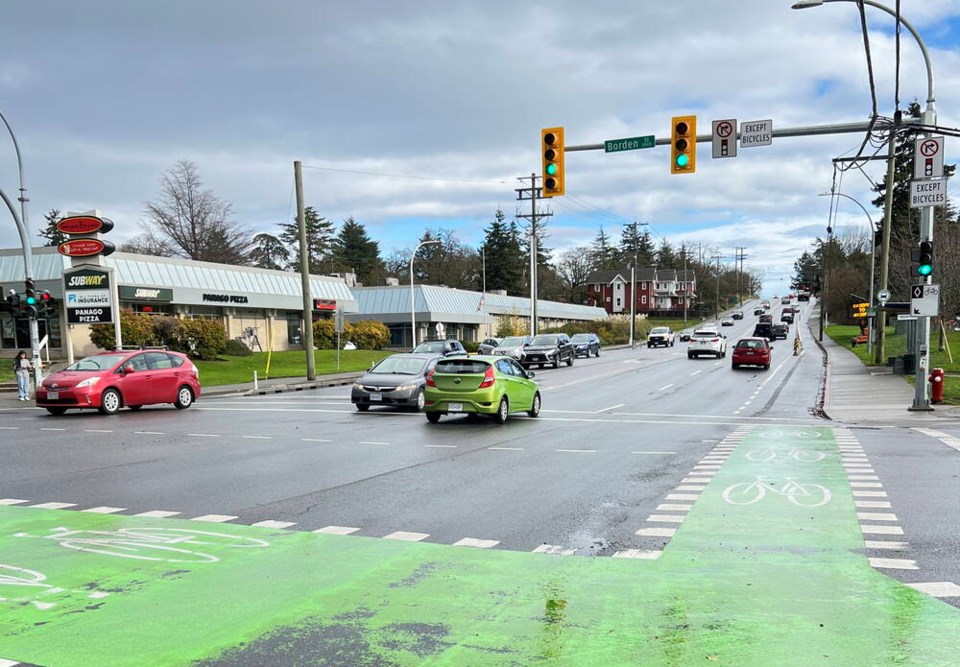A commentary by the executive director of the Victoria Transport Policy Institute, an independent research organization dedicated to developing innovative solutions to transport problems.
The Nov. 15 editorial, “Saanich’s plans call for clearer thinking,” and letters to the editor argue that Saanich should reject out-of-hand plans to create more walkable neighbourhoods and build bus and bike lanes on the Quadra/McKenzie corridor.
That would be a mistake. It’s time to apply more multimodal planning.
Bus and bike lanes increase affordability, efficiency and fairness. They support lower-cost modes, carry more people per lane, and ensure that non-drivers receive their fair share of public investments.
Multimodal planning responds to our changing travel needs. People are driving less and relying more on non-auto modes. In 2006 Capital Regional District residents made on average 3.5 trips per day, but this declined 26% to 2.6 daily trips in 2022.These trends help reduce congestion, consumer costs, accidents and pollution, but to take full advantage of them governments must improve non-auto infrastructure.
Every time somebody purchases a car they expect governments to build roads and businesses to provide off-street parking for their use. These facilities are costly: governments spend about a thousand dollars annually on roadways for each automobile, and businesses spend even more on each customer parking space.
Infrastructure for walking, bicycling and transit are much cheaper, so everybody saves when travellers use these modes rather than drive.
Critics underestimate the potential for non-auto travel. The editorial claims that bike and bus lanes would cause the vast majority of travellers to face massive traffic jams, citing statistics that only five per cent of travellers bike and only 11% use public transit, but those are averages for all of Saanich; non-auto mode shares tend to be higher on major arterials like Quadra and McKenzie, and are much higher on roads with dedicated lanes.
The editorial argues that bus and bike lanes would lead to “massive” traffic jams, but that’s not the way traffic really works.
Urban congestion tends to maintain equilibrium: it increases to the point that some travellers shift to other modes, times or destinations. Bus and bike lanes make these modes more attractive, reducing automobile trips and congestion.
To increase transportation efficiency we need “complete streets” designed to accommodate all modes so travellers can choose the best option for each trip: walking and bicycling for local errands, high quality public transit when travelling on busy corridors, and driving when it is truly optimal, considering all impacts.
Few travellers will give up driving altogether but surveys indicate that many residents want to drive less and rely more on non-auto modes provided they are convenient and safe.
Before you dismiss these ideas, I recommend searching the internet for information on “road diets,” “road space reallocation” and “disappearing traffic.”
The International Transport Forum’s report, Streets That Fit: Re-allocating Space for Better Cities, describes many successful examples of bus and bike lanes that increase travel efficiency and community livability.
My favourite success story is Paris. A decade ago, Anne Hidalgo was elected mayor with a vision for improving urban livability.
The city reallocated road space to bus lanes and bikeways, reduced parking spaces and traffic speeds, and improved sidewalks.
Although these policies were initially criticized with the same arguments we hear here, vehicle traffic subsequently declined 60% in the central city and 35% in suburbs, while walking, bicycling and public transit travel improved and increased.
Hidalgo was re-elected in 2020, demonstrating that once residents experience multimodal transportation, they like the results.
Saanich can create a more efficient and equitable transportation system by implementing the Quadra/McKenzie corridor plan.
Please give this opportunity open-minded consideration.



